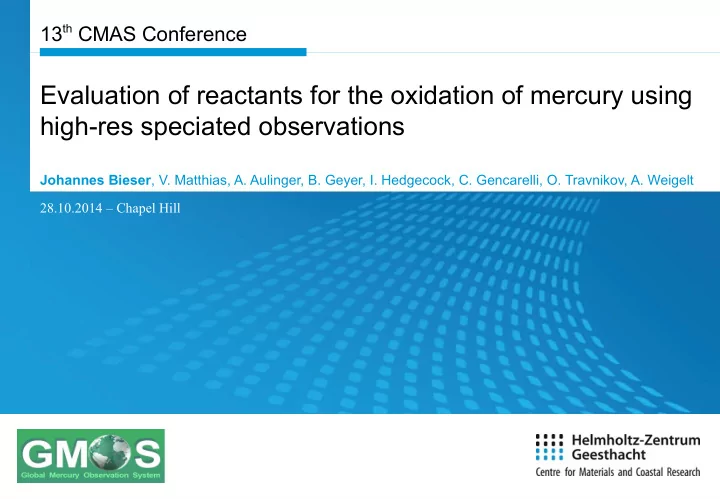

13 th CMAS Conference Evaluation of reactants for the oxidation of mercury using high-res speciated observations Johannes Bieser , V. Matthias, A. Aulinger, B. Geyer, I. Hedgecock, C. Gencarelli, O. Travnikov, A. Weigelt 28.10.2014 – Chapel Hill
Overview An Introduction to the GMOS project Overview of the model system Atmospheric mercury concentrations Mercury deposition Vertical profiles Discussion 2
Mercury: Global Cycle and Accumulation Amos et al., 2013 3
Emission, Chemistry, Transport, Deposition GEM ( G aseous E lemental M ercury) Hg 0 Background (NH) 1.5 – 1.8 ng/m³ Hg + GOM ( G aseous O xidized M ercury) Hg 2+ Background 1 – 30 pg/m³ PBM ( P article B ound M ercury) Hg P Background 10 – 100 pg/m³ 4
What is GOM? HgO, HgOH, Hg(OH) 2 HgCl 2 ,HgBrCl, HgBr 2 Hg + GOM: Hg 2+ HgBrOH, HgClOH HgC 2 O 4 5
GMOS: Global Mercury Observation System 6
GMOS: Measurements and Models 7
GMOS: Global Mercury Observation System 8
GMOS: Global Mercury Observation System 9
GMOS: Air craft based measurement campaigns 10
Model domain CMAQ 5.0.1 72 km x 72 km 24 km x 24 km 6 km x 6 km 30 sigma layers up to 100 hPa BC: GLEMOS, ECHMERIT Meteorology: CCLM, WRF Emissions: SMOKE-EU, AMAP 11
Measurement stations Station DE02: Waldhof (2009-present) – hourly GEM – 3 hourly GOM and PBM PM2.5 – weekly Hg wet only deposition – daily precipitation Secondary parameters: – ozone, SO 2 , SO 4 , NO X , NO 3 , NH 4 , CO, PM2.5 12
GEM: Comparison to observations MNB MNE R -0.06 0.12 0.33 13
Annual mercury wet deposition at Waldhof 14
The end of mercury science The End 15
Weekly mercury wet deposition at Waldhof CMAQ - default CMAQ – new Hg mech. MNB = 0.4 MNE = 0.6 (4.7 µg/m²) 16
PBM: Comparison to observations MNB MNE R 1.6 1.7 0.77 18
PBM: Sensitivity analysis MNB MNE R 0.3 1.6 0.6 1.7 0.77 0.77 19
PBM: Sensitivity analysis MNB MNE R 0.3 1.6 -0.5 0.6 1.7 0.7 0.77 0.77 0.21 20
PBM: Diurnal variability 21
PBM: Conclusions PBM concentrations can be explained by – primary emissions – particle conversion – transport The annual and diurnal variability of PBM indicate that it is not directly produced by oxidation 22
GOM: Comparison to observations MNB MNE R 14.0 14.0 0.2 23
GOM: Sensitivity runs MNB MNE R 9.0 14.0 0.9 9.0 14.0 1.0 -0.1 0.2 0.54 24
PBM: Diurnal variability 25
GOM: Different oxidants MNB MNE R 1.3 -0.8 -0.3 1.4 0.8 0.6 0.52 0.54 0.49 26
ozone [µg/m³] Ozone 27 ozone [ppbV]
GOM: Conclusions The diurnal variability of GOM indicates that it is related to photochemistry Production during summer could not be attributed to a certain reaction Production of GOM during winter can be explained by ozone reaction New Hg emission split: 89% GEM, 10% PBM, 1% GOM 28
Weekly mercury wet deposition at Waldhof CMAQ - default CMAQ – new Hg mech. MNB = 0.4 MNE = 0.6 (4.7 µg/m²) 29
Sensitivity runs: Wet deposition CMAQ - default CMAQ – updated (chemistry and emissions) MNB = 0.4 MNB = -0.01 MNE = 0.6 MNE = 0.3 (4.7 µg/m²) (3.2 µg/m² ) 30
Sensitivity runs: mercury deposition summer winter 31
Vertical profiles (GEM) Lipzia, Germany 32
Vertical profiles (GEM) Waldhof, Germany 33
Vertical profiles (GOM) Lipzia, Germany 34
Vertical profiles (GOM) Waldhof, Germany 35
Conclusions & Outlook New insights into mechanics of PBM and GOM formation Improvement of emission speciation Additional measurements will be available soon and allow to scrutinize these assumptions Analysis of additional air craft based observations Implementation of bromine emission and chemistry Additional regions (e.g.: asia, tropics, southern hemisphere) 36
Introduction 37
Concentrations with default mechanism GOM PBM pg/m³ 41
Frequency distribution of precipitation at Waldhof 43
Recommend
More recommend